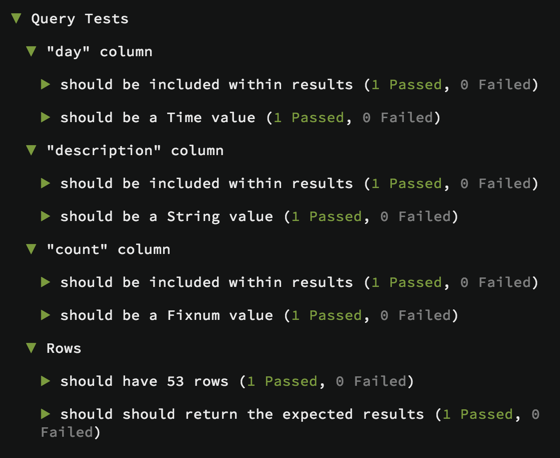Codewars has just released a new set of testing helpers to make writing and testing SQL kata even easier. Before we get into how these helpers make it easy to author kata, lets check out some of the additional benefits they provide to those training on the kata.
Expected Results
There is a new compare_with helper which takes in an example result set to compare the code warrior’s query against. This has a number of benefits, including presenting the code warrior with a 2nd table that shows the expected results output.

Charts
You may have also noticed in the above screenshot that there are 2 chart tabs. Another feature of the compare_with helper is that you can define charts to help visualize the data. Currently we support a timeseries chart type, and will be adding more later.

Using the compare_with helper
To use the compare_with helper, you simply add compare_with expected to your specs. Then, within your “preloaded” code, you add the expected query result like so:
def expected
DB[%q(
REPLACE WITH YOUR SQL QUERY
)].to_a
end
Not only will this print out both an ‘actual” and “expected” set of results, but this will also auto generate RSpec test specs for you based off of the data returned by the expected results. Here is an example of some specs that are auto-generated:

While these generated specs are great, there are some other ways of extending the generated specs.
describe block methods
You can tie into specific describe blocks to extend the specs that are shown. Here is an example of adding a spec to the “day column” describe block:
compare_with expected do column(:day) do
it "should start at the begining of the day" do
expect(actual.first[:day]).to eq expected.first[:day].beginning_of_day
end
end
end
There is also a rows method for tying into the rows block, and a spec block if you just want to add specs at the top describe of the generated tests.
chart method
There is also a chart method which can be used to configure charts that will be rendered against the actual and expected results. The following shows how to configure the chart previously shown.
compare_with expected do
draw_chart(
type: :timeseries,
group_by: :description,
x: :day,
y: :count
)
end
That about sums it up for now. If you want to see these new updates in action, head over to Codewars and check out a kata that already has it implemented.